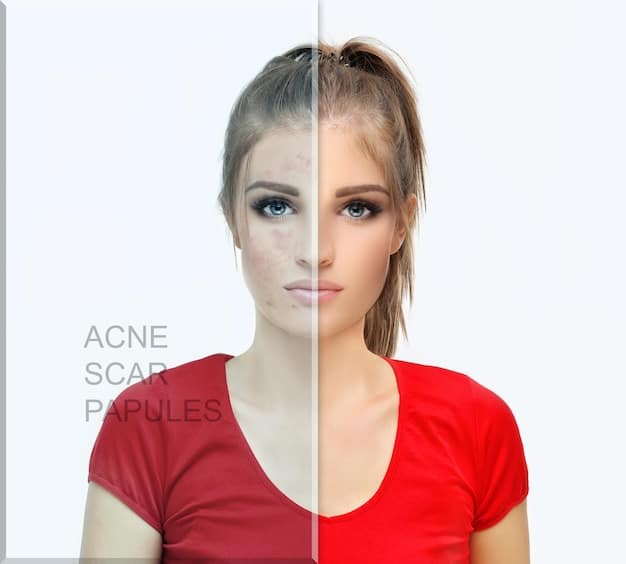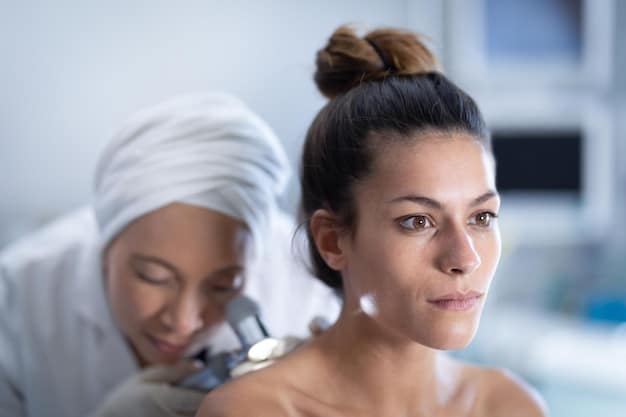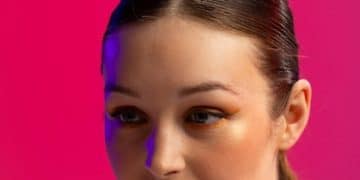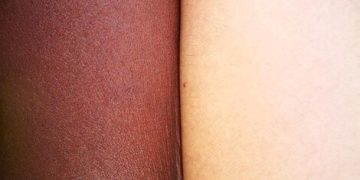Laser Skin Resurfacing: Achieve Younger Skin in 2025

Laser skin resurfacing is projected to be a highly effective cosmetic procedure in 2025, offering a 75% success rate in reducing wrinkles and improving overall skin tone by using targeted laser technology to stimulate collagen production and remove damaged outer layers.
Ready to reveal a more youthful you? Laser skin resurfacing: Reducing wrinkles and improving skin tone with a 75% success rate in 2025 is becoming increasingly popular, offering a promising solution for those seeking to rejuvenate their appearance.
What is Laser Skin Resurfacing?
Laser skin resurfacing is a cosmetic procedure that uses lasers to improve the texture and appearance of your skin. It’s a popular option for addressing wrinkles, age spots, scars, and uneven skin tone.
This treatment involves removing layers of skin, allowing new, healthier skin to grow. The precision of lasers allows for targeted treatment, minimizing damage to surrounding tissues.
Laser resurfacing can be ablative or non-ablative. Ablative lasers remove the outer layers of skin, while non-ablative lasers stimulate collagen production without removing skin layers.
Types of Laser Skin Resurfacing
There are several types of laser skin resurfacing, each with its own advantages and disadvantages. Understanding these options can help you choose the best treatment for your skin concerns.
Ablative lasers, such as CO2 and Er:YAG lasers, are more aggressive and provide significant results but require longer recovery times. Non-ablative lasers, like pulsed dye and Nd:YAG lasers, are gentler with less downtime but may require multiple sessions for optimal results.
- CO2 Lasers: Effective for deep wrinkles, scars, and warts, but require significant downtime.
- Erbium Lasers: Best for fine lines and superficial wrinkles, with a shorter recovery period compared to CO2 lasers.
- Pulsed Dye Lasers: Used for treating redness, broken capillaries, and rosacea.
- Fractional Lasers: Treat small areas of skin, reducing recovery time while still providing noticeable improvements.
Laser skin resurfacing offers a transformative solution for various skin concerns. As technology advances, the precision, effectiveness, and safety of these treatments continue to make them a popular choice for individuals seeking skin rejuvenation.
Benefits of Laser Skin Resurfacing

Laser skin resurfacing offers a multitude of benefits beyond just wrinkle reduction. It’s a versatile treatment that addresses various skin imperfections, leading to a more youthful and radiant complexion.
Patients often report increased confidence and satisfaction with their appearance after undergoing laser resurfacing. The treatment can improve skin tone, texture, and overall clarity.
One of the primary advantages is its precision, allowing doctors to target specific areas with minimal impact on surrounding skin. This precision leads to faster healing and reduced risk of complications.
Reducing Wrinkles and Fine Lines
One of the most significant benefits of laser skin resurfacing is its ability to diminish wrinkles and fine lines. The laser stimulates collagen production, which plumps the skin and reduces the appearance of wrinkles.
The heat from the laser also tightens the skin, further reducing the visibility of wrinkles and creating a smoother surface.
Laser treatments are tailored to each patient’s skin type and condition, ensuring optimal results. This personalized approach maximizes wrinkle reduction and minimizes potential side effects.
Improving Skin Tone and Texture
Laser skin resurfacing can dramatically improve skin tone and texture by removing damaged outer layers. This reveals fresher, more even-toned skin underneath.
Treatments can reduce the appearance of sunspots, age spots, and other forms of hyperpigmentation, resulting in a more uniform complexion.
The stimulation of collagen and elastin also enhances the skin’s texture, making it smoother and more supple.
Laser skin resurfacing offers a comprehensive approach to skin rejuvenation by addressing wrinkles, improving skin texture, and promoting collagen production. With advancements in technology, patients can achieve significant improvements in their skin’s appearance, boosting their confidence and overall quality of life.
Ideal Candidates for Laser Skin Resurfacing
Not everyone is an ideal candidate for laser skin resurfacing. Understanding the factors that make someone a good candidate is crucial for ensuring safe and effective treatment.
Generally, individuals with fair skin and light hair tend to experience the best results. However, advancements in laser technology have made the treatment safer and more effective for those with darker skin tones as well.
A thorough consultation with a qualified dermatologist or cosmetic surgeon is essential to determine if laser skin resurfacing is right for you.
- Skin Type: Lighter skin types generally have a lower risk of post-inflammatory hyperpigmentation.
- Overall Health: Good overall health is important, as certain medical conditions can affect healing.
- Realistic Expectations: Understanding the potential outcomes and limitations of the procedure is key to satisfaction.
Conditions Laser Skin Resurfacing Can Treat
Laser skin resurfacing is effective for treating a variety of skin conditions. From sun damage to acne scars, lasers can offer significant improvement.
The precision of laser treatments allows for targeted correction of imperfections, making it a versatile option for many individuals.
Conditions such as fine lines, wrinkles, sun damage, age spots, acne scars, and uneven skin tone can all be effectively treated with laser resurfacing.
When to Avoid Laser Skin Resurfacing
There are certain situations and conditions where laser skin resurfacing should be avoided. Understanding these contraindications is vital for patient safety.
Individuals with active skin infections, certain autoimmune diseases, or a history of keloid scarring should avoid laser treatments.
Pregnant or breastfeeding women and those taking certain medications may also need to postpone or avoid laser resurfacing.
Determining candidacy for laser skin resurfacing involves assessing skin type, overall health, and specific skin conditions. Consulting with a qualified professional and understanding the potential risks and limitations ensures that patients can make informed decisions about their treatment options.

The Laser Skin Resurfacing Procedure: What to Expect
Knowing what to expect during a laser skin resurfacing procedure can help alleviate anxiety and ensure you are prepared for the treatment.
A typical procedure involves several steps, from initial consultation to post-treatment care. Understanding each phase is essential for achieving the best possible results.
The procedure begins with a consultation, followed by skin preparation, the laser treatment itself, and finally, post-treatment care.
Pre-Treatment Preparations
Proper preparation before a laser skin resurfacing procedure is crucial for minimizing risks and maximizing results. Following your doctor’s instructions carefully is essential.
Avoid sun exposure, tanning beds, and certain skin care products in the weeks leading up to your treatment. This helps reduce the risk of complications.
Your doctor may also recommend using specific creams or medications to prepare your skin. These products can help improve the outcome of the laser treatment.
During the Procedure
The laser skin resurfacing procedure itself typically takes between 30 minutes to two hours, depending on the size and complexity of the treatment area.
A topical anesthetic is usually applied to minimize discomfort during the procedure. Some patients may also receive oral or intravenous sedation.
The laser is then carefully guided over the skin, delivering precise pulses of energy to remove damaged layers and stimulate collagen production.
Post-Treatment Care and Recovery
Post-treatment care is vital for ensuring proper healing and achieving the best possible results. Following your doctor’s instructions is crucial for a smooth recovery.
Expect some redness, swelling, and peeling in the days following the procedure. Keep the treated area clean and moisturized.
- Cleansing: Gently cleanse the treated area with a mild cleanser as directed by your doctor.
- Moisturizing: Apply a thick layer of moisturizer to keep the skin hydrated and promote healing.
- Sun Protection: Protect your skin from the sun by wearing a broad-spectrum sunscreen with an SPF of 30 or higher. Avoid direct sun exposure as much as possible.
Understanding the laser skin resurfacing procedure, from preparation to recovery, ensures patients are well-informed and can achieve optimal results. By following pre and post-treatment guidelines, individuals can minimize risks and maximize the benefits of this transformative cosmetic procedure.
Potential Risks and Side Effects
While laser skin resurfacing is generally safe, like any medical procedure, it carries potential risks and side effects. Being aware of these can help you make an informed decision.
Common side effects include redness, swelling, itching, and peeling. These are usually temporary and resolve within a few days to weeks.
More serious complications are rare but can include infection, scarring, and changes in skin pigmentation.
Common Side Effects
The most common side effects of laser skin resurfacing are typically mild and temporary. They are a normal part of the healing process.
Expect some redness, swelling, and peeling in the days following the procedure. These side effects usually subside within a week or two.
Itching and mild discomfort can also occur, but can be managed with over-the-counter pain relievers and soothing creams.
Rare but Serious Complications
Although rare, more serious complications can occur with laser skin resurfacing. It’s important to recognize these and seek prompt medical attention if they arise.
Infection is a potential risk, especially if proper post-treatment care is not followed. Signs of infection include increased redness, swelling, pain, and pus.
Scarring and changes in skin pigmentation, such as hyperpigmentation or hypopigmentation, can also occur, particularly in individuals with darker skin tones.
Understanding the potential risks and side effects of laser skin resurfacing is essential for making an informed decision and ensuring proper post-treatment care. While most side effects are mild and temporary, being aware of more serious complications allows patients to seek timely medical attention and minimize long-term effects.
The Future of Laser Skin Resurfacing: 2025 and Beyond
The field of laser skin resurfacing is continuously evolving, with new technologies and techniques emerging to improve safety and effectiveness.
Looking ahead to 2025 and beyond, we can expect to see even more advancements in laser technology, making treatments more precise, less invasive, and more accessible.
These advancements are driven by ongoing research and development, aimed at addressing the limitations of current laser systems and expanding the range of treatable skin conditions.
Expected Advancements in Technology
Emerging laser technologies are expected to offer improved precision, reduced downtime, and enhanced results. These advancements aim to make laser skin resurfacing more appealing to a wider range of patients.
Fractional lasers are becoming more sophisticated, allowing for even more targeted treatment with minimal impact on surrounding tissues. This results in faster healing and reduced risk of complications.
- Improved Precision: Lasers with enhanced precision can target specific areas more effectively, minimizing damage to surrounding tissues
- Reduced Downtime: Newer technologies aim to shorten recovery times, allowing patients to return to their normal activities sooner.
- Enhanced Results: Advancements focus on delivering more significant and longer-lasting improvements in skin tone, texture, and wrinkle reduction.
Increase in the Success Rate
With ongoing advancements projected for 2025, the success rate of laser skin resurfacing is expected to rise to 75%. This will be driven by improved technology, tailored protocols, and refined techniques that optimize outcomes for various skin types and conditions.
As laser systems become more sophisticated, doctors will be able to customize treatments more effectively, leading to higher patient satisfaction and better overall results.
Cost and Accessibility
As technology advances and laser systems become more widespread, the cost of laser skin resurfacing is expected to become more competitive and accessible.
Increased competition among providers and the development of more affordable laser systems may lead to lower treatment costs.
The integration of laser skin resurfacing into more dermatology and cosmetic practices will also improve accessibility, making treatments more convenient for patients.
The future of laser skin resurfacing looks promising, with advancements in technology, the estimated increase in the succes rate and improved accessibility on the horizon. As the field continues to evolve, patients can look forward to safer, more effective, and more affordable treatments that deliver transformative results.
| Key Point | Brief Description |
|---|---|
| ✨ Reduces Wrinkles | Stimulates collagen for smoother skin. |
| 🌟 Improves Tone | Evens out skin pigmentation & texture. |
| 🎯 Targeted Treatment | Precise correction of imperfections. |
| 🧪 Future Tech | Advancements promise better results. |
Frequently Asked Questions
▼
The results of laser skin resurfacing can last for several years, depending on the type of laser used and individual skin characteristics. Maintaining good skincare habits helps prolong the effects.
▼
Most patients experience only mild discomfort during the procedure, thanks to topical anesthetics. Some may opt for additional sedation to ensure a comfortable experience.
▼
The number of sessions varies based on individual skin condition and treatment goals. Some may achieve desired results in one session, while others may require multiple treatments.
▼
Recovery time differs by the type of laser used; ablative lasers require longer recovery than non-ablative. Generally, expect redness and peeling for a week, followed by gradual healing.
▼
Costs range depending on laser type and treatment area. Ablative lasers could cost more due to intensity and recovery. Consult providers for exact costs, and research possible financing.
Conclusion
Laser skin resurfacing stands as a promising cosmetic procedure for those seeking to rejuvenate their appearance. As technology advances toward 2025, the projected 75% success rate in and beyond laser skin resurfacing: reducing wrinkles and improving skin tone with a 75% success rate in 2025 makes it more appealing. While potential risks exist, advancements should only yield better results over time.





